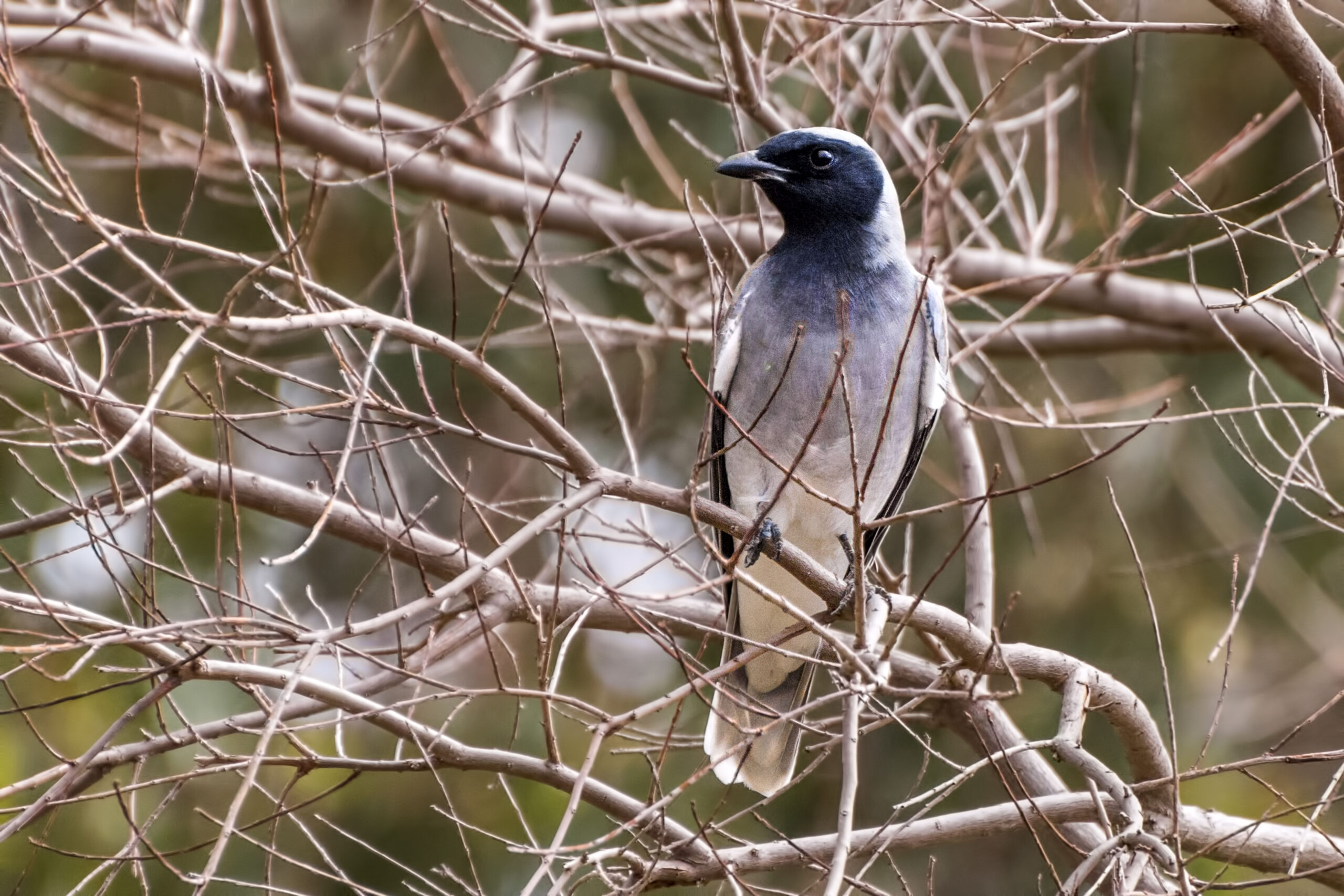A graceful bird of silvery plumage and quiet resolve, the Black-faced Cuckoo-shrike (Coracina novaehollandiae) is a familiar sight across much of Australia. With its soft trilling call and fluid, gliding flight, it embodies the understated elegance of Australia’s open woodlands and urban edges. Despite its name, it is neither a true cuckoo nor a shrike, but belongs to the Campephagidae family – a group of insectivorous birds with a widespread distribution through Australasia. Well-adapted and widely distributed, this species is an important thread in the fabric of Australia’s avian ecosystems.
Identification
The Black-faced Cuckoo-shrike is a medium-sized bird, typically 32 to 36 cm in length. It is easily identified by its sleek grey body, black facial mask and slightly hooked black bill. The wings and tail are darker grey to blackish, with a subtle barring visible in flight. Juveniles lack the pronounced black face and display more mottled underparts. The plumage is soft and satiny and the species often exhibits a characteristic wing-shuffling motion when perched. Its call is a soft, repeated “creer-creer” or churring sound, often delivered during short gliding flights.
Habitat and Distribution
This species is one of Australia’s most widely distributed passerines, occurring across every mainland state and reaching into parts of Tasmania and southern New Guinea. It inhabits a range of environments including open forests, woodlands, shrublands, riparian zones and modified habitats such as farmlands, golf courses and suburban gardens. It is particularly abundant in areas with scattered eucalypts, where it forages high in the canopy. Although largely resident in some regions, populations in southern Australia may migrate north during winter.
Ecological Role
The Black-faced Cuckoo-shrike plays a valuable ecological role as a predator of insects and other invertebrates. It feeds on beetles, caterpillars, grasshoppers and spiders, often gleaning prey from leaves and branches mid-flight. In doing so, it helps regulate insect populations in both natural and agricultural landscapes. It also consumes fruits and seeds, contributing to seed dispersal. As a canopy forager, it fills an important niche alongside other insectivorous birds, helping maintain ecological balance across diverse habitats.
Behaviour and Reproduction
Usually seen alone, in pairs, or small family groups, Coracina novaehollandiae is relatively quiet and unobtrusive in behaviour. During the breeding season – typically from August to February – it constructs a shallow bowl-shaped nest of bark, grass and spider web, usually high in a tree fork. Both parents share incubation and feeding duties. The clutch typically contains 2-3 eggs, which hatch after around 20 days. Fledglings are dependent on the parents for several weeks. Outside the breeding season, the species forms loose flocks and may travel considerable distances in search of food.
Conservation Status
The Black-faced Cuckoo-shrike is listed as Least Concern under both the Queensland Nature Conservation Act 1992and the Western Australian Biodiversity Conservation Act 2016, reflecting its wide distribution and stable population trends across Australia. It is not considered threatened at either the state or national level.
Threats
While not currently under significant conservation pressure, the species may be affected locally by habitat degradation, particularly the removal of mature trees used for nesting and foraging. Urban development, large-scale agriculture and increased fire frequency can reduce the availability of suitable habitat. Additionally, prolonged drought and climate variability may affect insect prey availability in certain regions.
Conservation Efforts
No specific conservation programs target this species, owing to its widespread and secure status. However, general habitat conservation initiatives – such as the retention of mature trees, planting of native vegetation and promotion of insect-rich environments – benefit the species. Its tolerance of human-altered landscapes makes it an excellent ambassador for urban wildlife conservation efforts.
Final Thoughts
With its subtle beauty and quiet resilience, the Black-faced Cuckoo-shrike is a reminder of the hidden complexity within Australia’s common bird species. As it drifts between treetops or pauses to shuffle its wings in the sunlight, it demonstrates that even familiar birds contribute richly to the health and rhythm of the ecosystems they inhabit. Safeguarding its habitat ensures that this graceful species continues to thrive in both bushland and backyards across the country.
Fauna Resources specialises in the safe handling of a range of different fauna species, through safe, effective and ethical fauna solutions. By providing dedicated fauna services, through passionate fauna spotter catchers and fauna specialists, we can support the unique terrestrial ecosystems and rich biodiversity Australia has to offer.
For more information about our specialist fauna services contact Fauna Resources today.

